October 20, 2025

The article titled "10 ABC Data Examples to Enhance Behavior Analysis Practices" underscores the critical role of ABC data collection in refining behavior analysis methodologies across diverse settings. Systematic documentation of antecedents, behaviors, and consequences is not merely beneficial; it is essential. This practice empowers behavior analysts and educators to discern patterns and craft targeted interventions. The outcome? More effective behavioral management and improved results for individuals undergoing ABA therapy.
Consider this: how can systematic documentation transform your approach to behavior analysis? By leveraging ABC data, practitioners can enhance their understanding of behavioral patterns, leading to interventions that are not only tailored but also impactful. This strategic approach ultimately fosters positive outcomes, reinforcing the efficacy of ABA therapy.
In conclusion, embracing ABC data collection is a pivotal step toward elevating behavior analysis practices. By committing to this method, professionals can ensure they are not just managing behavior but actively facilitating growth and improvement for those they serve.
Understanding the intricacies of behavior is essential in various fields, particularly in education and therapy. The demand for Board Certified Behavior Analysts (BCBAs) is growing, highlighting the need for effective strategies in behavior analysis. ABC data collection, which systematically records antecedents, behaviors, and consequences, serves as a powerful tool for behavior analysts aiming to enhance intervention strategies. This article explores ten compelling examples of ABC data in action, illustrating how these practices can transform behavior analysis and improve outcomes for individuals.
As practitioners delve into these methodologies, they may wonder:
The demand for Board Certified Behavior Analysts (BCBAs) is at an all-time high, making it crucial for healthcare employers to connect with the right talent. Hire ABA specializes in linking BCBAs with premier job opportunities in the dynamic field of Applied Behavior Analysis (ABA) therapy. Our platform streamlines the hiring process by effectively matching qualified candidates with employers seeking specific skills and expertise.
Through personalized resume assessments, we thoroughly evaluate candidates' experiences and career goals, ensuring optimal job matching. Utilizing advanced job fit scoring, we identify opportunities that align with candidates' skills, preferences, and desired locations. This tailored approach not only enhances job satisfaction but also contributes significantly to the overall effectiveness of ABA therapy services across various settings.
For healthcare employers, Hire ABA provides a streamlined pathway to connect with qualified BCBAs. Are you facing challenges in finding the right fit for your needs? Let us simplify your recruitment process and ensure you secure the best talent in the field. Trust Hire ABA to deliver reliable connections that meet your specific requirements.
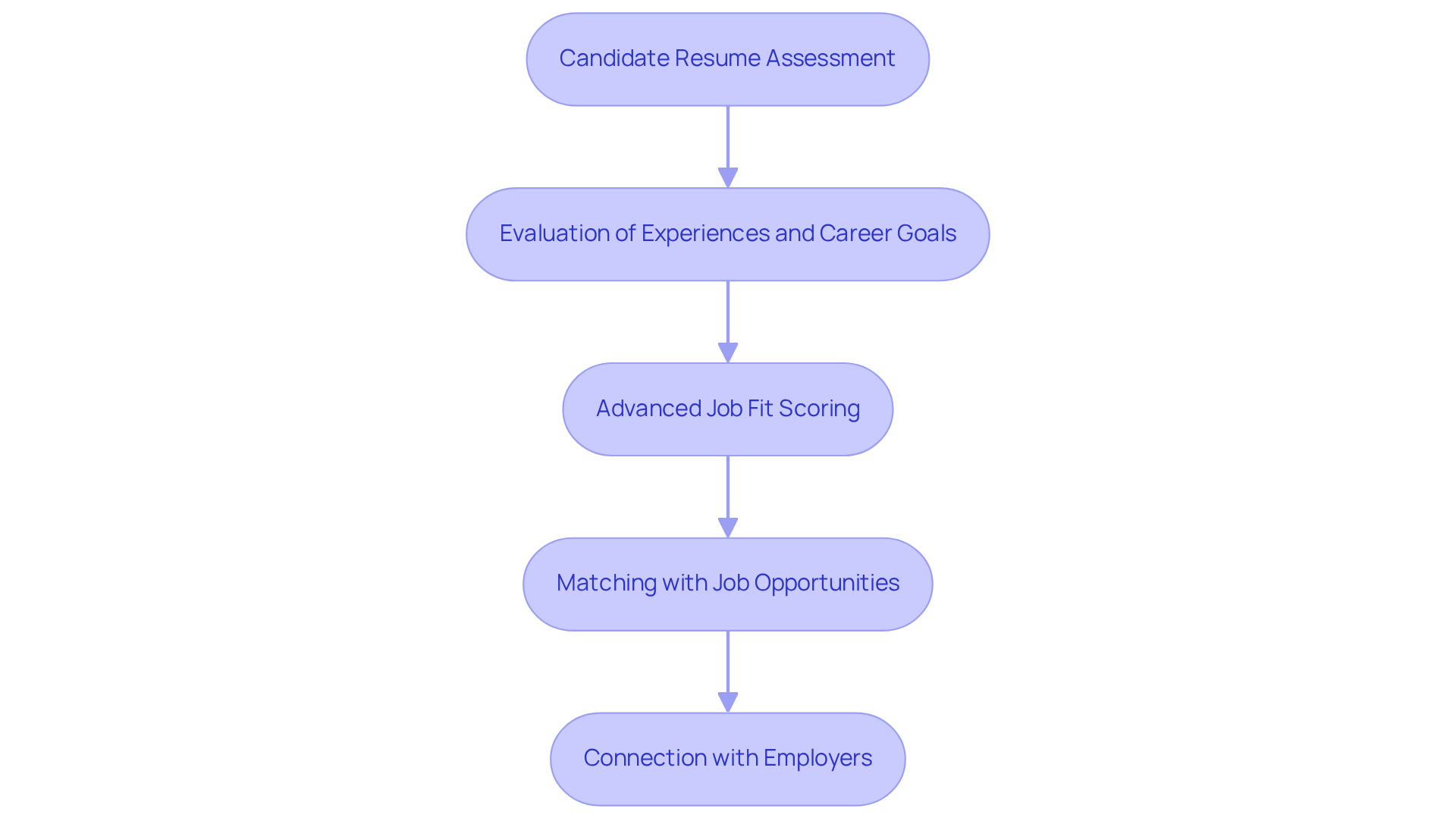
In a typical classroom scenario, a teacher might observe a student frequently leaving their seat during lessons. This behavior warrants attention. By utilizing ABC information gathering, the instructor meticulously notes the antecedent (the teacher asking a question), the action (the student standing up), and the consequence (the student receiving attention from peers). This systematic method clarifies the triggers and outcomes linked to the actions, empowering the instructor to devise targeted interventions aimed at improving classroom conduct.
Notably, studies indicate that approximately 75% of teachers employ ABC information gathering techniques, underscoring its essential role in effective conduct management strategies. Through careful examination of this information, educators can identify trends that inform personalized intervention strategies (BIPs), ultimately fostering a more supportive learning atmosphere.
For instance, in a specific case study, an educator applied ABC record gathering to address disruptive behaviors, resulting in a remarkable 30% decrease in incidents over a semester due to the systematic evaluation of the gathered information. Such real-life applications vividly illustrate the transformative potential of abc data examples in enhancing classroom conduct and supporting student success.
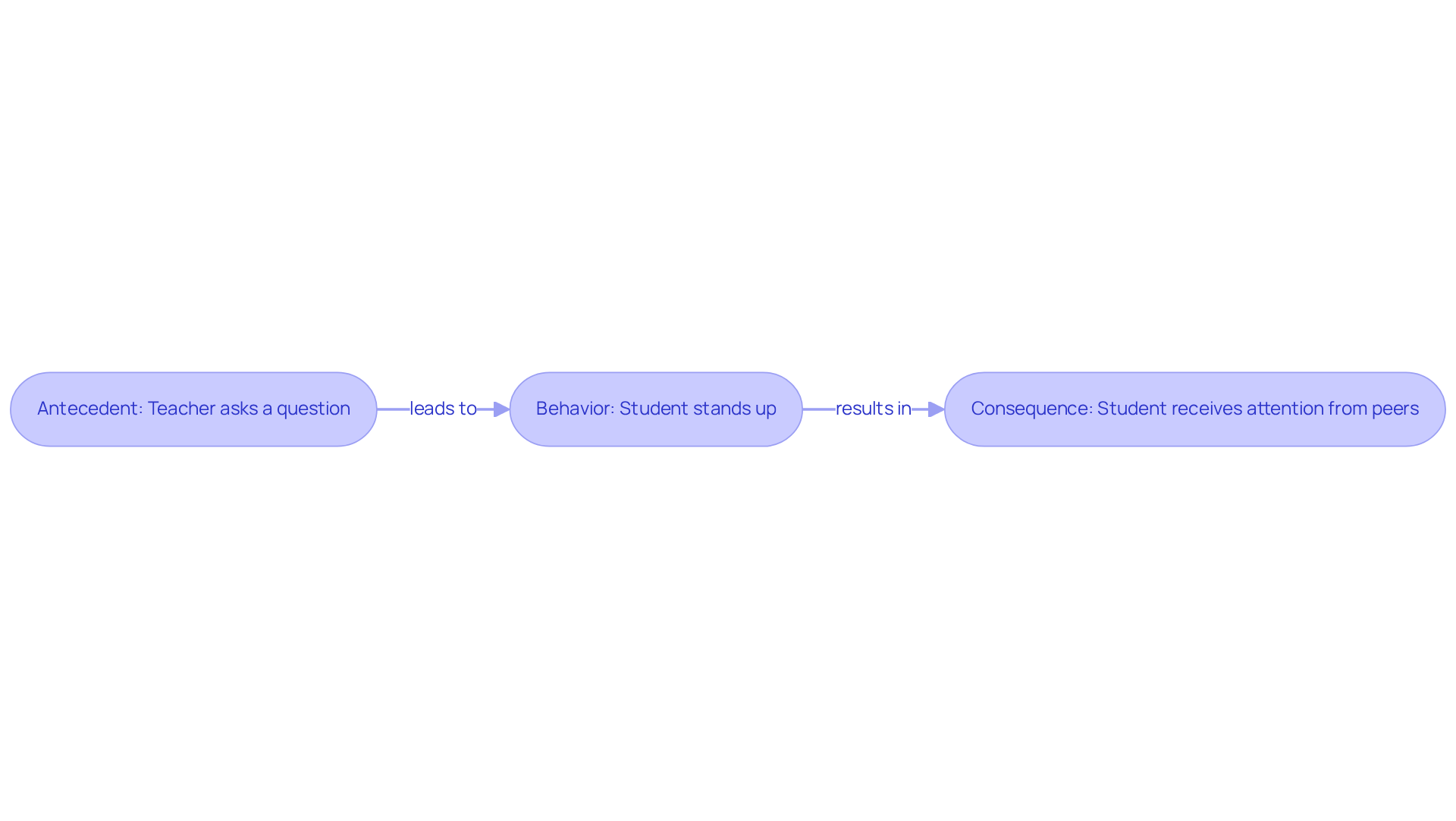
Tracking antecedents involves documenting events that occur immediately before an action, while tracking consequences focuses on what happens right after. Consider this: if a child throws a tantrum when asked to clean up, the antecedent is the request to clean, and the consequence might be the child receiving a toy as a distraction. This systematic documentation is crucial.
Studies indicate that:
Common triggers include:
By meticulously recording these elements, analysts can identify patterns that inform effective intervention strategies. For instance, if a child consistently exhibits tantrums following requests to clean, it may indicate a need for alternative approaches to transitions. Understanding the antecedents and consequences can also aid in developing tailored interventions, such as Parent-Child Interaction Therapy (P.C.I.T.).
This therapy consists of 14 to 17 weekly sessions and has proven effective in managing behavioral issues in children aged two to seven. It emphasizes the importance of positive reinforcement and structured interactions, ultimately fostering better emotional regulation and compliance in children.
As specialists highlight, 'The key is to educate the parent that temper tantrums are harmless.' This statement underscores the significance of comprehending these actions in a developmental context. Parents are encouraged to document tantrum occurrences to identify patterns and triggers, facilitating more effective management strategies.
![]()
By examining abc data examples, analysts can identify trends over time. For instance, if data reveals that a child often displays aggressive conduct after shifts between activities, this trend suggests a possible requirement for more organized transitions. Understanding these patterns allows for the development of tailored interventions that address specific behavioral issues using abc data examples.
Research indicates that:
As one expert observed, "One of the primary principles of ABA is that we modify socially significant actions to make a difference in our client's lives." By recognizing these behavioral patterns, analysts can create more effective, individualized plans that foster positive behavioral changes in children.

The ABC information sheet stands as a critical resource in behavioral analysis, empowering practitioners to systematically record antecedents, actions, and outcomes. This structured approach not only aids in monitoring conduct over time but also provides a clear framework for analyzing data. Research demonstrates that thorough assessment through structured documentation significantly enhances the effectiveness of intervention strategies in ABA therapy. By utilizing an ABC record, analysts can guarantee that their documentation is comprehensive and adheres to industry standards, facilitating effective intervention planning.
Efficient documentation tools, including digital platforms like ABC Data Pro and customizable templates available online, streamline the information-gathering process, enabling practitioners to analyze and interpret ABC data examples and trends in conduct effectively. Moreover, establishing baseline measurements of actions before implementing interventions is crucial for evaluating progress and tailoring strategies. To maximize the utility of ABC information sheets, analysts should focus on:
This method fosters collaboration among stakeholders, such as parents and educators, thereby enhancing the overall effectiveness of ABA therapy. Impartial observers, including action analysts and skilled instructors, play a vital role in collecting accurate ABC information, ensuring that interventions are evidence-based and tailored to individual needs.
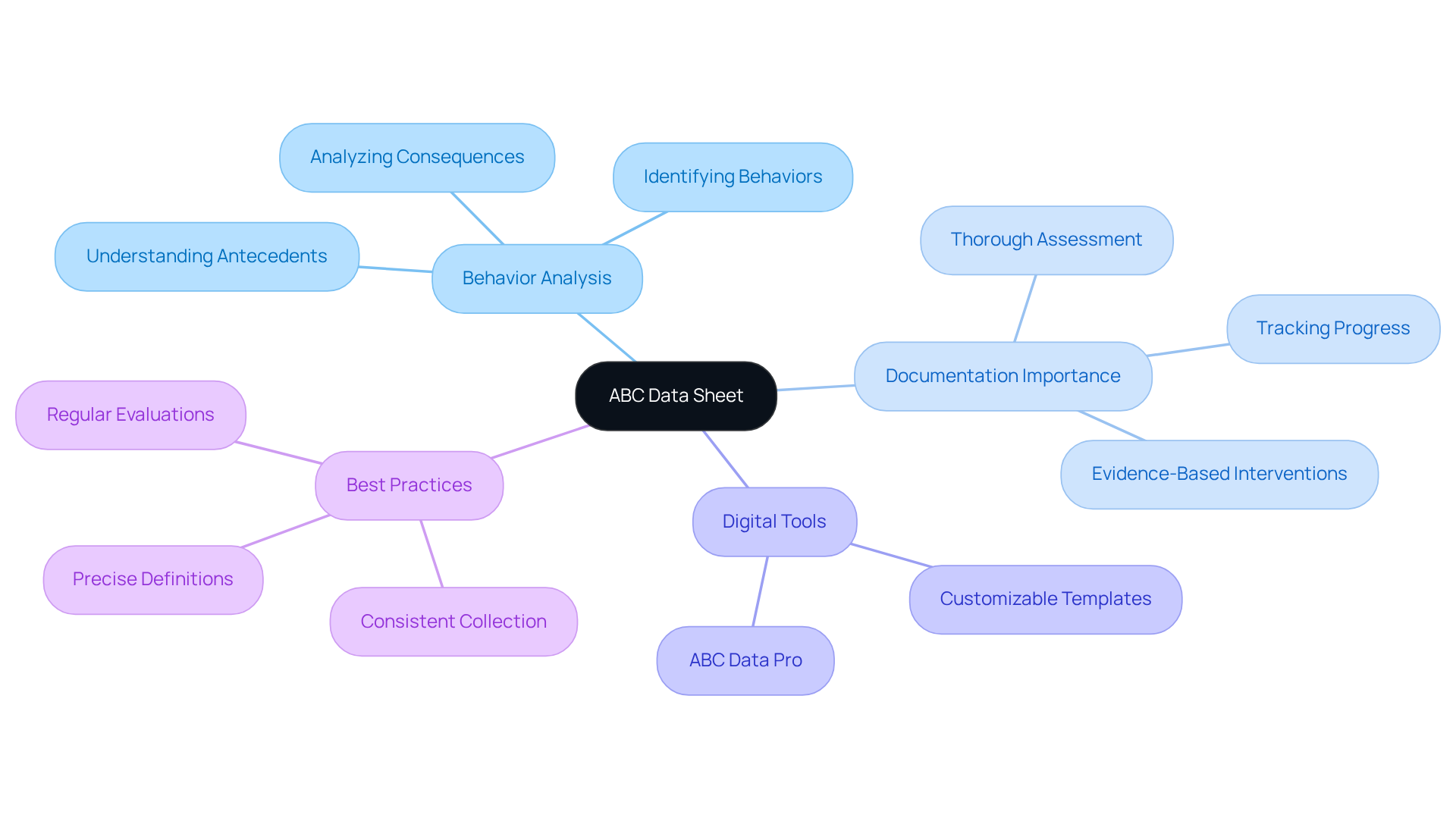
Behavior Intervention Plans (BIPs) achieve their maximum effectiveness when grounded in precise ABC information analysis. By systematically analyzing this information, analysts can uncover the underlying purposes of specific behaviors, leading to the creation of targeted interventions. For example, if ABC data indicates that a child exhibits disruptive behavior primarily to evade challenging tasks, the BIP can be tailored to adjust task demands while incorporating reinforcement strategies that encourage on-task behavior.
Research underscores that interventions based on comprehensive ABC information are significantly more effective. Studies reveal that BIPs informed by multi-source data collection are 65% more likely to yield substantial behavioral improvements. Additionally, understanding the functions of behaviors—such as attention-seeking, escape/avoidance, access to tangible items, and sensory reinforcement—empowers practitioners to design interventions that tackle the root causes of behaviors rather than merely addressing their symptoms.
Case studies further illustrate the successful application of ABC information in BIPs. One notable study focused on a child whose tantrums were associated with insufficient attention during group activities. By implementing a BIP that provided structured attention in these settings, the frequency of tantrums diminished significantly, showcasing the efficacy of data-driven decision-making.
Incorporating ABC information into BIPs not only enhances the precision of interventions but also fosters a collaborative approach among educators, parents, and behavior analysts. This ensures consistency in strategies across various environments. Such a holistic perspective is essential for fostering positive behavioral changes and improving overall outcomes for children receiving ABA therapy.
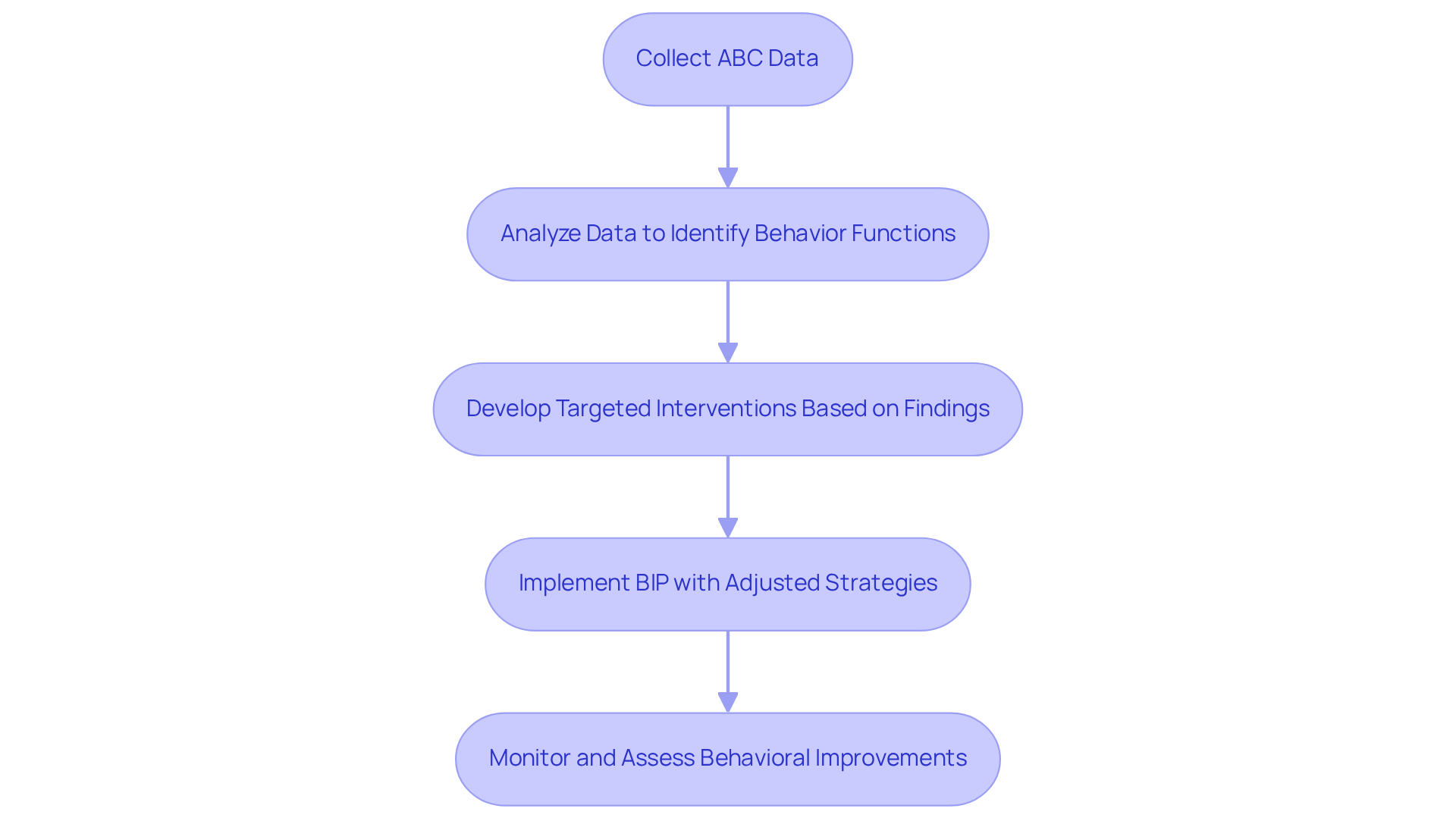
Consistency in collecting abc data examples is essential for ensuring the reliability and validity of behavioral information. Unreliable information can lead to deceptive conclusions and unproductive interventions, ultimately obstructing client progress. Studies indicate that a significant proportion of behavior analysts encounter challenges with information consistency, underscoring the necessity for robust protocols. In fact, programs that employ consistent digital information gathering demonstrate a 35% faster advancement toward behavioral objectives compared to those utilizing inconsistent techniques.
To enhance reliability, practitioners should establish clear protocols for data collection, which include:
As stated by the Behavior Analyst Certification Board (BACB), 'systematic information gathering is not merely suggested but necessary for ethical ABA practice.' Furthermore, a prominent analyst emphasizes, "Establishing clear information gathering protocols is not merely a best practice; it's essential for ethical ABA practice." Another specialist notes, "Without consistency in our information, we risk making decisions based on flawed details."
By adhering to these best practices, behavior analysts can enhance the precision of their information gathering efforts, as shown in abc data examples, leading to more effective interventions and improved outcomes for clients. Practitioners are encouraged to implement these protocols in their practice to uphold the highest standards of integrity.
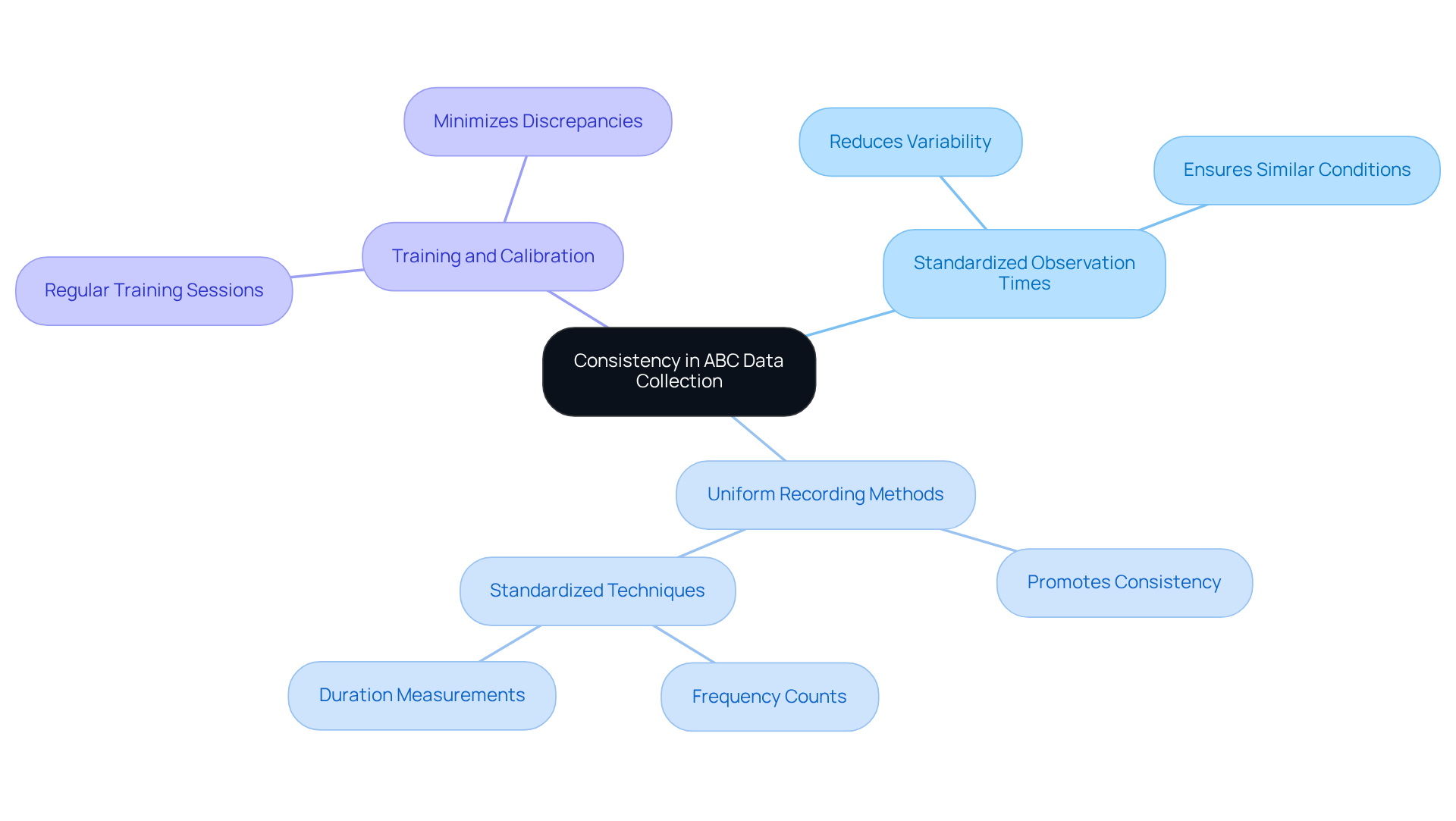
ABC information collection is a versatile tool that can be applied across various settings, including schools, homes, and clinical environments. In educational settings, for example, educators can utilize ABC information to effectively monitor student actions during class activities. Similarly, guardians can implement this approach at home to gain insights into their child's conduct during everyday routines. This adaptability underscores the value of abc data examples as an essential resource for behavior analysts working in diverse contexts.

Effective ABC information gathering is often obstructed by typical obstacles such as time limitations, inconsistent documentation, and inadequate training. To tackle these challenges, organizations must prioritize the execution of thorough training programs aimed at enhancing ABC information gathering practices. Research indicates that approximately 70% of organizations are now implementing training programs to refine their information gathering techniques. These initiatives not only equip personnel with essential skills but also establish clear protocols that significantly enhance the information collection process.
Furthermore, incorporating technology can bolster these efforts, leading to more efficient documentation and analysis. Behavior analysts assert that the use of contemporary tools can substantially reduce the time spent on information input, allowing professionals to focus on delivering effective interventions. For instance, training programs that integrate technology have shown improvements in accuracy and reliability, ultimately resulting in better outcomes for individuals undergoing ABA therapy.
Analysts emphasize the transformative impact of training and technology in the realm of information gathering. One analyst remarked, 'Investing in training is investing in the quality of our interventions.' Additionally, Jodi Petersen highlighted, 'Information is the language of the powerholders,' underscoring the necessity of reliable information in conduct analysis. By addressing these obstacles through targeted training and technological integration, organizations can significantly enhance the quality and dependability of the information collected, paving the way for more effective conduct analysis practices. Moreover, initiating information gathering early can provide organizations with valuable insights more swiftly, thereby improving their interventions.

The function of ABC information in activity analysis is undergoing a significant transformation, particularly due to advancements in technology. As we look towards the future, we can anticipate the integration of digital tools for information gathering, real-time analytics, and enhanced visualization techniques. These innovations will empower behavior analysts to collect and analyze data with greater efficiency, ultimately leading to improved intervention strategies and outcomes. Given the continuous growth of the field, it is crucial for practitioners to remain informed about these trends to ensure they are providing the highest quality of care possible.
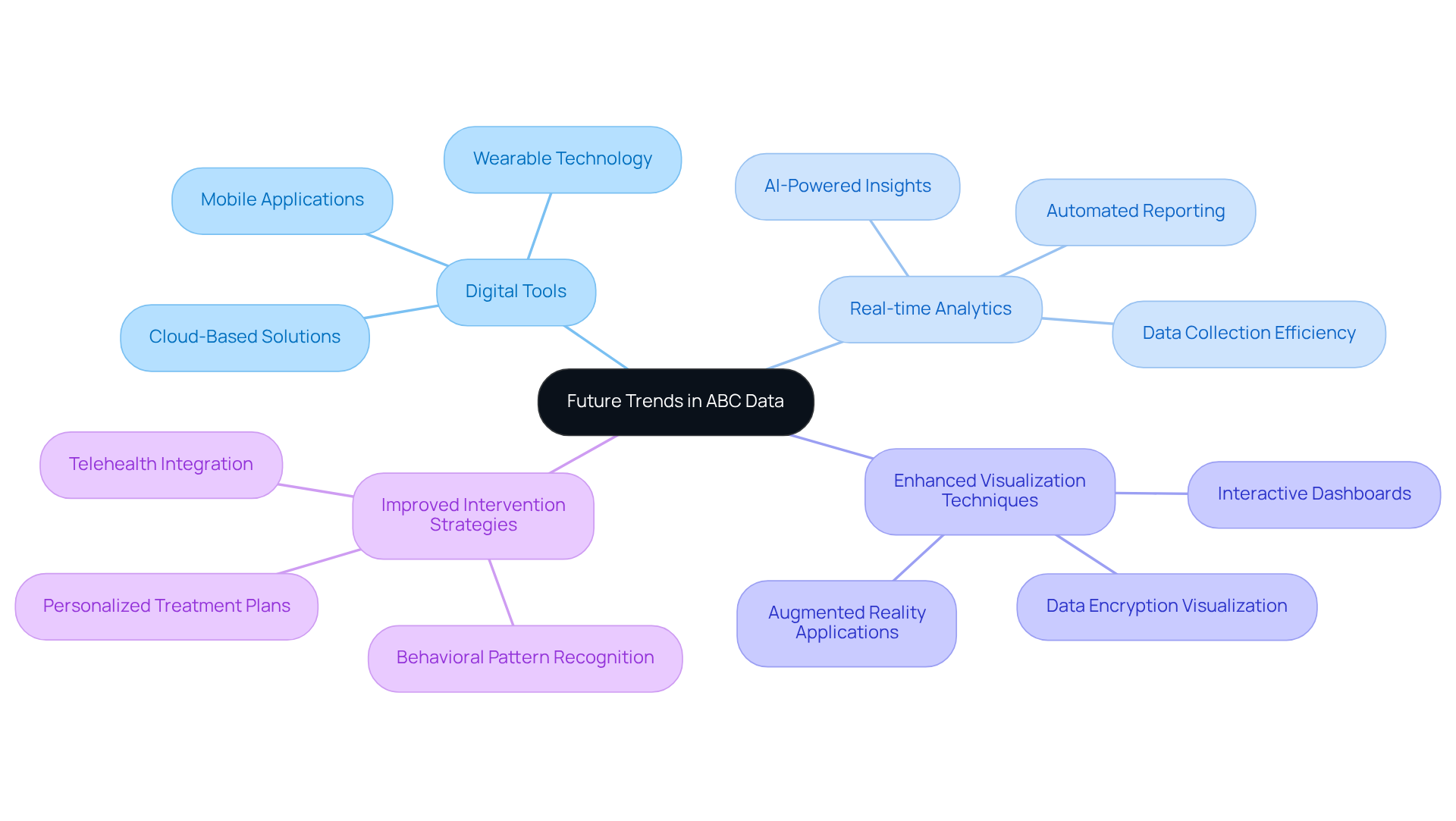
The significance of ABC data in behavior analysis is paramount. This structured approach to understanding behavior—capturing antecedents, actions, and consequences—serves as a cornerstone for effective interventions across various settings. By leveraging ABC data, practitioners can identify patterns, tailor interventions, and ultimately enhance behavioral outcomes for individuals, particularly in educational and therapeutic environments.
Throughout this article, various examples illustrate the practical applications of ABC data collection. These range from tracking antecedents and consequences to implementing Behavior Intervention Plans (BIPs) based on thorough data analysis. The importance of consistency in data collection practices is emphasized as a means to ensure reliable outcomes. Furthermore, the integration of technology and training programs emerges as a pivotal strategy for overcoming common barriers in data gathering, reinforcing the need for ongoing professional development in the field.
As behavior analysis continues to evolve, staying informed about advancements in ABC data collection methods will be essential for practitioners. Embracing these changes not only enhances the quality of interventions but also ensures that behavior analysts can meet the growing demands of their roles. By prioritizing effective data practices, professionals can significantly improve the lives of those they serve, paving the way for a future where data-driven strategies lead to meaningful behavioral change.
What is Hire ABA?
Hire ABA is a platform that specializes in connecting Board Certified Behavior Analysts (BCBAs) with job opportunities in Applied Behavior Analysis (ABA) therapy. It streamlines the hiring process by matching qualified candidates with employers based on specific skills and expertise.
How does Hire ABA enhance the job matching process for BCBAs?
Hire ABA enhances job matching through personalized resume assessments and advanced job fit scoring, which evaluate candidates' experiences, career goals, skills, preferences, and desired locations. This tailored approach improves job satisfaction and the effectiveness of ABA therapy services.
What challenges do healthcare employers face when hiring BCBAs?
Healthcare employers often struggle to find the right fit for their needs when hiring BCBAs. Hire ABA aims to simplify the recruitment process and connect employers with qualified talent in the field.
What is ABC data collection in the context of classroom behavior management?
ABC data collection involves systematically documenting the antecedent (what happens before a behavior), the behavior itself, and the consequence (what happens after the behavior). This method helps educators identify triggers and outcomes related to student behaviors, allowing for targeted interventions.
How prevalent is the use of ABC information gathering among teachers?
Approximately 75% of teachers utilize ABC information gathering techniques as part of their conduct management strategies, highlighting its importance in fostering effective classroom environments.
Can you provide an example of how ABC data collection can lead to improved classroom behavior?
In a case study, a teacher used ABC record gathering to address disruptive behaviors, resulting in a 30% decrease in incidents over a semester. This demonstrates how systematic evaluation of behavior data can enhance classroom conduct and support student success.
What are antecedents and consequences in behavioral tracking?
Antecedents are events that occur immediately before a behavior, while consequences are what happens right after the behavior. For example, if a child throws a tantrum when asked to clean up, the request to clean is the antecedent, and receiving a toy as a distraction is the consequence.
What common triggers can lead to tantrums in young children?
Common triggers for tantrums in children include fatigue, hunger, and frustration. Understanding these triggers can help in developing effective intervention strategies.
What is Parent-Child Interaction Therapy (P.C.I.T.)?
P.C.I.T. is a therapy consisting of 14 to 17 weekly sessions aimed at managing behavioral issues in children aged two to seven. It focuses on positive reinforcement and structured interactions to foster better emotional regulation and compliance.
How can parents effectively manage their child's tantrums?
Parents are encouraged to document occurrences of tantrums to identify patterns and triggers, which can facilitate more effective management strategies. Understanding that tantrums are a normal part of development is also important for parents.
Our expert recruitment strategies and AI-driven sourcing ensure that you receive top-notch candidates quickly, without compromising on quality. Whether you’re looking for BCBAs, Clinical Directors, or RBTs, we’ve got you covered.